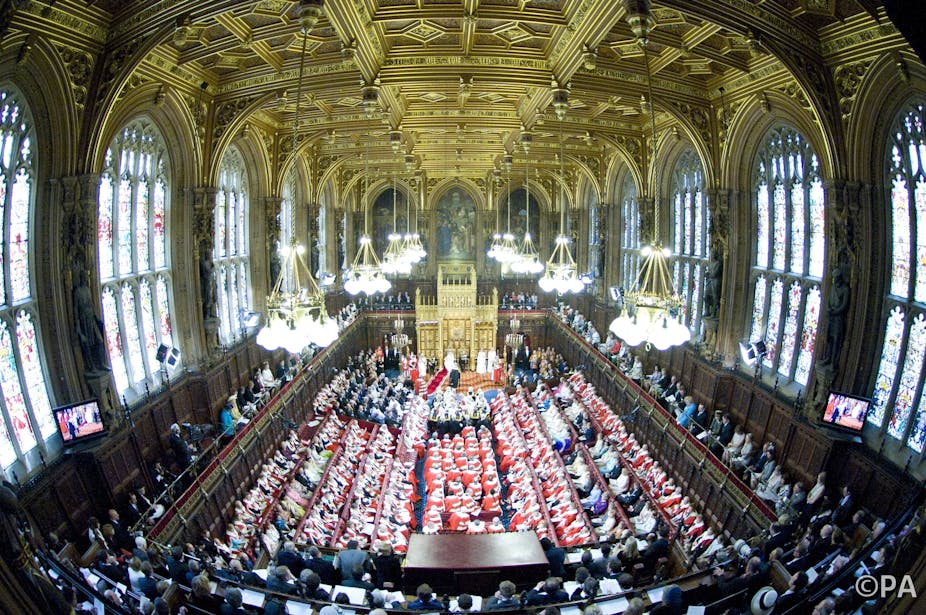The Queen’s Speech marks the start of the fourth and final session of the 2010 Parliament. Final sessions are usually relatively uncontroversial. An approaching general election has traditionally calmed things down in the Commons. Fewer MPs want to rock the boat.
There is usually less serious legislation to cause trouble, anyway. Why introduce controversial legislation knowing that an election called in the middle of the session will cause it to fall? Why cause unnecessary resentment among your own backbenchers? It all tended to combine to produce what Churchill once called the “odour of dissolution”.
The rules of the game have changed now, though. One consequence of the government’s Fixed-Term Parliaments Act is that – barring something unforeseen – this session should go the distance. With no need to curtail the session mid-way through, legislation announced today should in most cases be able to reach the statute book. This gives slightly less scope for inter-party game playing (it makes it riskier to introduce bills just to differentiate yourself from the opposition) and it raises the stakes for intra-party dissent (unhappy backbenchers can no longer keep quiet, knowing that dissolution will kill a bill with which they have concerns).
And rather than just one governing party binding together to face a forthcoming contest, we now have two parties, both keen to differentiate themselves from one another. The Lib Dem bit of the government will not mind doing things that infuriate Conservative backbenchers; the Conservative bit of the government will delight in doing things to wind up Lib Dem backbenchers.
Rocky road ahead
So this may be a rockier final session than many. And while many MPs will say they place a premium on unity as the general election approaches, their behaviour thus far in the parliament has not demonstrated any great ability to actually deliver that unity.
Together with my colleague Mark Stuart, I have just compiled a report on the Coalition’s backbench parties since 2010, entitled The Four Year Itch. The 2013-2014 session saw a Coalition backbench rebellion in 31% of divisions, topping the comparable figure for all but five post-war sessions. And the rate for the parliament as a whole (that is, 2010-14) now stands at a rebellion in 37% of divisions, meaning the parliament is on course to be (almost certainly) the most rebellious since 1945.

To give you some comparable examples, throughout the whole of the Thatcher and Major era backbench rebellion averaged a rebellion in 14% of divisions. During the Blair and Brown years, the figure was 19%. It is now 37%.
Most backbench rebels are Conservative – as are most of the very rebellious MPs – but then there are more Conservative MPs. But while numerically smaller, rebellion is much more widespread amongst the Lib Dems. Whereas just over half (52%) of Conservative MPs have rebelled, a total of 42 Lib Dems, or 72% of the parliamentary party, have now done so.
Indeed, once you exclude those Lib Dem MPs who are or were at some point members of the “payroll vote”, either as ministers or parliamentary private secretaries – and thus expected to remain loyal to the government, there is now not a single Lib Dem MP who has been on the backbenches throughout the parliament and who has remained loyal to the party whip.
Bolshy backbenchers abound
And it is not just the quantity of rebelliousness that is remarkable, but its quality. The events of the last session are a reminder of the extent to which the ferocity of backbench independence has increased recently. The one outright Commons defeat was over Syria (which saw the largest Coalition rebellion of the session) and which was historically unprecedented. But there were also several very high-profile retreats, over both last year’s Queen’s Speech and the Immigration Bill, in both cases seeing the Conservative part of the Coalition forced to allow backbenchers a free vote to avoid massive rebellions.
Both the latter issues were driven by the muscular Euroscepticism that is now dominant on the Conservative backbenches. Rebellions by Conservative MPs in the last session over non-European issues had a median average size of just five MPs. Those over Europe had a median average of 23.
An often unremarked aspect of both these latter votes – as with the votes in the preceding parliament on boundary changes – was that there was no coherent government position. The Conservative frontbench abstained, the Liberal Democrats were whipped to vote down the amendments and joined Labour in doing so on both occasions. What was the position of Her Majesty’s government on the Queen’s speech or the Immigration Bill amendment? Answer: it depended which bit of Her Majesty’s government you talk to.
Still, if you think it’s rough now, just imagine what it might be like after the next election if the Conservatives manage to stay in government. If the Conservatives manage to get an overall majority, it is – putting it politely – difficult to imagine it will be a large majority. Ditto if they are propped up by the DUP. The only real prospect of a decent-sized majority for a Conservative prime minister after the next election would appear to be some fresh arrangement with the Liberal Democrats, however many of them are left. None of this looks like a recipe for harmony.

